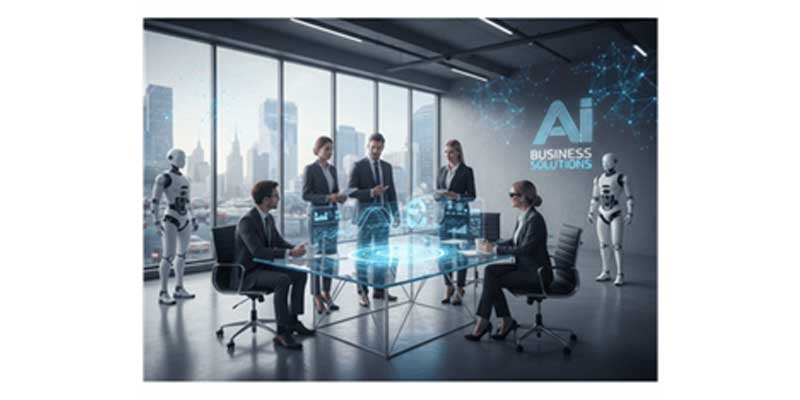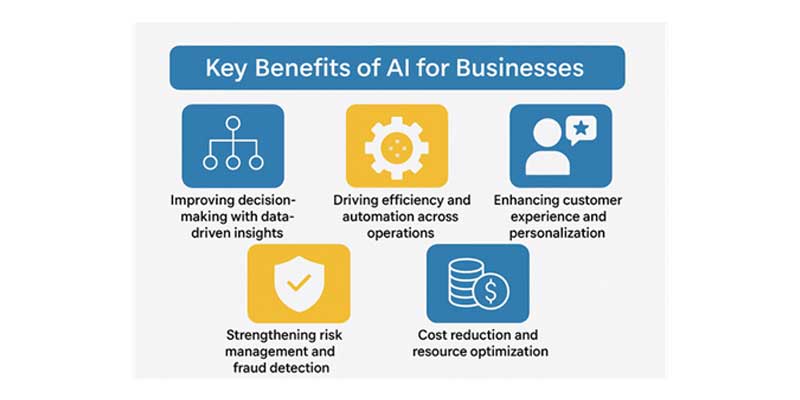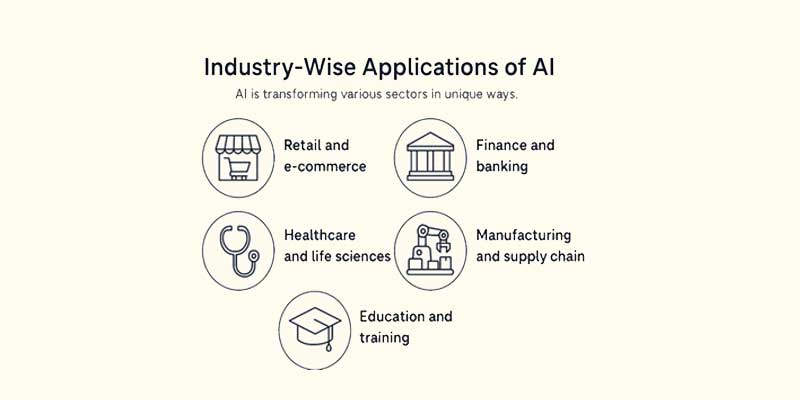

In today's rapidly evolving digital landscape, businesses are constantly seeking innovative ways to gain a competitive edge, optimise operations, and enhance customer experiences. Artificial intelligence (AI) is a revolutionary technology that has come to change the face of business processes, providing plenty of opportunities to transform everything from routine tasks to analytical insights from big data. Once a concept of science fiction, AI is now a concrete reality that is transforming industries everywhere around the world. This article will explore the benefits of AI in business, the importance of AI in business and AI innovations.
For decades, businesses relied on traditional systems—rule-based software, static data reports, and manual decision-making frameworks. While effective in their time, these systems often struggled with agility, scalability, and the ability to process complex, unstructured data.
Artificial Intelligence (AI) marks a major departure from this legacy approach. Unlike traditional systems, AI doesn’t just follow instructions—it learns, adapts, and predicts. Machine learning models can analyze millions of data points in real time, uncover patterns invisible to humans, and continuously improve performance without explicit reprogramming. This shift has transformed industries, enabling proactive problem-solving, automation of repetitive tasks, and customer experiences that feel more personalized than ever before.
In business, AI refers to the use of algorithms and machine learning models to mimic human cognitive processes—thinking, reasoning, and decision-making—but at a scale and speed far beyond human capability. It goes beyond automation by enabling systems to recognize speech, understand natural language, detect anomalies, and even generate creative outputs.
For companies, AI is not a singular technology but an ecosystem that includes:
By embedding AI into daily operations, businesses achieve deeper insights, streamline processes, and unlock new revenue opportunities that would be impossible through manual methods.
The year 2025 represents a critical turning point in AI adoption for three reasons:
In short, AI is no longer experimental—it has moved into mainstream strategy. Businesses that delay adoption risk not just competitive disadvantage but also missing out on entire new markets created by AI-driven innovation.
In today’s fast-paced market, decisions based on intuition alone are risky. AI systems aggregate massive volumes of structured and unstructured data—from sales numbers, supply chain logs, customer feedback, social media, to market trends—and process them to reveal patterns, correlations, and projections that humans may miss.
By leveraging predictive models and real-time analytics, business leaders can make proactive decisions: anticipating demand, identifying emerging threats, optimizing investment, and prioritizing initiatives with measurable ROI. For organizations evaluating ai for business, deploying these insight-driven tools means less guesswork, faster reaction times, and more strategic alignment across departments.
Operational workflows often include repetitive, time-consuming tasks: data entry, payroll processing, inventory tracking, report generation. AI and intelligent automation empower businesses to automate these functions, freeing up human talent for higher-value work.
Robotic Process Automation (RPA), combined with AI, can monitor processes, trigger actions, and even correct anomalies without manual oversight. The result: fewer errors, lower turnaround times, and operations that scale much more smoothly when demand fluctuates.
Customers increasingly expect brands to understand—and anticipate—their needs. AI enables hyper-personalization at scale: from product recommendations based on past behavior, to dynamic pricing, to tailored content via email or chat.
Using natural language processing (NLP) and sentiment analysis, businesses can respond to customer feedback faster, deliver support proactively, and craft messaging that resonates on an individual level. A strong customer experience not only boosts loyalty, but also turns users into advocates, which is especially powerful in competitive markets.
With growing digital transactions and data flows, risk exposure and fraudulent activity have likewise increased. AI tools can continuously monitor patterns, flag anomalies, and learn over time what “normal” behavior looks like versus suspicious deviations.
For finance, insurance, e-commerce, and any business handling sensitive transactions, deploying AI-powered risk analytics helps in early detection of fraud, compliance breaches, and even cybersecurity threats. By addressing risk proactively, companies protect both their reputation and bottom line.
Cost savings is among the most immediate benefits of AI integration. Through automation, waste reduction, smarter inventory management, energy optimization, and process improvements, businesses can lower operating costs significantly.
AI helps in forecasting needs so that resources—whether human, material, or infrastructural—are neither under-utilized nor over-stretched. Whether it’s optimizing supply chain logistics, reducing downtime in manufacturing, or streamlining staffing levels in services, intelligent systems contribute to leaner, more efficient operations.

In industries where speed to market defines success, AI shortens innovation timelines dramatically. Machine learning models can analyze customer feedback, competitor launches, and market gaps to identify opportunities for new products. Generative AI tools accelerate prototyping by simulating designs, predicting material performance, and even generating marketing copy.
This reduces the time and cost associated with traditional R&D, allowing businesses to test, refine, and launch products faster. Companies that adopt AI in their development pipelines not only stay ahead of competitors but also set industry benchmarks for agility and responsiveness.
Accurate forecasting has always been a challenge, but AI makes it more precise. By processing historical sales data, economic indicators, seasonality, and real-time consumer behavior, AI models can predict future demand with far greater accuracy than traditional methods.
For businesses, this translates into smarter inventory management, reduced stockouts, and minimized overproduction. In volatile markets, these predictions also help executives make confident decisions about pricing, marketing campaigns, and expansion strategies, ensuring they maintain a competitive edge even in uncertain conditions.
Today’s customers gravitate toward brands that make them feel understood. AI enables hyper-personalization, tailoring products, services, and communications to individual preferences at scale. From customized e-commerce recommendations to dynamic loyalty programs and personalized advertising, AI makes it possible to create experiences that feel unique to each customer.
This level of personalization goes beyond retention—it builds emotional loyalty, turning one-time buyers into repeat advocates. For businesses, it is no longer just a “nice-to-have,” but a differentiator that can make or break market leadership.
Sustainability is no longer an afterthought—it is central to business strategy. AI supports Environmental, Social, and Governance (ESG) goals by optimizing energy use, reducing waste in supply chains, and helping organizations measure their carbon footprint with accuracy.
For example, AI can suggest sustainable materials, optimize delivery routes to cut emissions, and even model the long-term environmental impact of business decisions. Companies that integrate AI into their ESG frameworks not only improve efficiency but also build trust with stakeholders and meet regulatory requirements, positioning themselves as responsible industry leaders.

AI has become the backbone of modern retail and e-commerce, where personalization and convenience drive customer loyalty. Recommendation engines suggest products based on browsing and purchase history, increasing sales conversion rates. Dynamic pricing algorithms adjust costs in real time based on demand, competition, and inventory. AI-powered chatbots and virtual assistants ensure 24/7 customer support, while visual search tools allow shoppers to find products by uploading images. These innovations not only boost customer satisfaction but also maximize revenue opportunities.
In finance, AI is transforming how institutions handle risk, compliance, and customer engagement. Fraud detection systems analyze transaction patterns to flag anomalies instantly, reducing losses. Predictive models forecast market movements and support better investment strategies. Personalized banking solutions, powered by AI-driven insights, provide tailored financial advice to customers. Additionally, AI chatbots streamline routine queries, enhancing customer service while reducing operational costs.
AI applications in healthcare are revolutionizing patient care and research. Diagnostic algorithms can detect diseases like cancer or neurological conditions earlier than traditional methods. In drug discovery, AI accelerates the identification of potential compounds, shortening R&D timelines. Personalized medicine—where treatments are customized based on genetic and lifestyle data—is becoming a reality with AI. Hospitals also use predictive analytics for patient flow management, resource allocation, and improving treatment outcomes.
AI brings efficiency and precision to manufacturing and logistics. Predictive maintenance ensures machines are serviced before they fail, reducing downtime. Computer vision enhances quality control by identifying product defects on production lines. In supply chain management, AI optimizes routes, reduces fuel consumption, and forecasts demand to prevent stockouts or overstocking. This combination of efficiency and foresight translates into cost savings and competitive advantage.
AI is reshaping how learners interact with knowledge. Adaptive learning platforms customize educational content to suit individual learning styles and speeds, improving outcomes. Virtual tutors and AI-driven chatbots provide instant support to students, while analytics tools help educators identify struggling learners early. In corporate training, AI-powered simulations and virtual reality environments prepare employees for real-world challenges, making upskilling more engaging and effective.
While AI promises long-term savings and innovation, the upfront costs can be significant. Businesses often need to invest in advanced infrastructure, skilled talent, and integration with existing systems. Small and mid-sized enterprises may find these barriers harder to overcome compared to large corporations. Additionally, scaling AI solutions beyond pilot projects remains a challenge—what works in one department may not easily replicate across the organization. Without careful planning, companies risk stalled initiatives and wasted budgets.
AI thrives on data, but this reliance introduces major privacy and security concerns. Sensitive information—whether customer records, financial data, or health profiles—must be protected against breaches and misuse. Compliance with regulations such as GDPR, HIPAA, or local data protection laws adds complexity. Furthermore, the increasing use of third-party AI platforms raises concerns about data ownership and transparency. Businesses must balance the benefits of data-driven intelligence with robust safeguards to maintain trust.
AI models learn from data—but if that data carries human bias, the results may reinforce unfair or discriminatory outcomes. From hiring algorithms that unintentionally favor certain demographics to loan approval systems that disadvantage specific groups, ethical risks are real and visible. Beyond bias, there are questions about accountability: who is responsible when an AI system makes a wrong or harmful decision? Companies must adopt ethical AI frameworks, diverse datasets, and transparent review processes to ensure fairness and accountability.
Automation powered by AI can displace roles that involve repetitive or routine tasks. While this drives efficiency, it also creates anxiety among employees about job security. The greater challenge lies in reskilling—preparing workers for new roles where human judgment, creativity, and empathy complement AI systems. Organizations that fail to invest in workforce training risk resistance to adoption and morale issues. On the other hand, companies that pair AI with strong upskilling programs can turn disruption into an opportunity for growth and innovation.
Successful AI adoption begins with more than just technology—it requires cultural readiness. Leadership must set a clear vision for how AI fits into the company’s future. Employees at all levels should understand not only the benefits but also the limitations of AI. Encouraging an innovation-friendly culture, where experimentation is welcomed and failures are treated as learning opportunities, helps organizations adapt more smoothly. Without buy-in across the workforce, even the most advanced AI tools may struggle to deliver value.
AI is not an end in itself; it is a means to accelerate business objectives. Companies should avoid deploying AI simply because competitors are doing so. Instead, they should start by identifying pain points—such as high customer churn, inefficient supply chains, or poor forecasting—and then match these with AI capabilities. When AI projects are tied directly to strategic goals like revenue growth, customer retention, or sustainability, they stand a higher chance of delivering measurable impact.
The AI landscape is vast, ranging from machine learning platforms to natural language processing, computer vision, and generative AI solutions. Businesses must carefully evaluate which tools best fit their industry and scale. Beyond technology, selecting reliable partners—vendors, consultants, or system integrators—is critical. Trusted partners provide expertise, ensure smooth implementation, and support long-term maintenance. A thoughtful approach prevents wasted investment in tools that look promising but fail to integrate with existing systems.
AI is not a one-time project—it’s a living system that improves over time. Continuous monitoring ensures that models remain accurate, unbiased, and aligned with business needs. Feedback loops from users, customers, and real-world data help identify when retraining or adjustments are required. Businesses should set up governance structures to review performance, compliance, and ethical considerations on an ongoing basis. Regular optimization not only maximizes ROI but also ensures AI stays relevant as markets and technologies evolve.
AI is set to evolve from being a competitive advantage to a baseline requirement for doing business. Over the next decade, we will see increased integration of AI with emerging technologies such as quantum computing, blockchain, and the Internet of Things (IoT). These combinations will enable unprecedented levels of speed, transparency, and connectivity.
Another key trend is the rise of explainable AI (XAI)—systems that provide clear reasoning behind their decisions. This will help businesses build trust with regulators, customers, and stakeholders. Finally, sector-specific AI solutions will become the norm, moving away from one-size-fits-all platforms toward specialized tools tailored to healthcare, manufacturing, retail, and more.
Generative AI is redefining creativity and problem-solving in business. From generating product designs and marketing content to simulating business scenarios, it allows organizations to innovate faster. Combined with machine learning at scale, businesses will be able to analyze real-time global data, adjust strategies instantly, and predict future opportunities or risks with accuracy.
As these technologies mature, their cost of entry will decline, allowing even small and medium-sized enterprises to benefit. Businesses that master large-scale deployment of generative AI and machine learning will be positioned to dominate their industries through innovation, adaptability, and speed.
A central debate in AI adoption is whether machines will replace human roles or augment them. The future is likely to be a hybrid model: AI handles repetitive, data-heavy, and predictive tasks, while humans focus on creativity, empathy, strategic decision-making, and leadership.
Businesses that embrace this partnership will unlock the highest value—using AI to expand human potential rather than diminish it. For example, in healthcare, AI can process scans and lab data, but doctors interpret results within a human context. In marketing, AI can generate campaign ideas, while creative teams refine them with brand voice and emotional nuance.
Ultimately, the businesses of the future will thrive by positioning AI as a collaborator, not a competitor, ensuring technology enhances human impact rather than replaces it.
Artificial Intelligence has moved beyond being a futuristic concept—it is now a foundational driver of business performance. From customer personalization to risk management and from operational efficiency to sustainable growth, AI is proving indispensable across industries. Competitors who adopt AI are not just improving efficiency; they are reshaping entire business models.
In this environment, companies that delay adoption risk losing market share, missing innovation opportunities, and becoming irrelevant in the eyes of both customers and stakeholders. AI is no longer a choice—it is a necessity for businesses that aim to remain competitive in 2025 and beyond.
For decision-makers, the path forward is clear but requires thoughtful execution. Leaders should:
By approaching AI adoption with a balance of vision and pragmatism, leaders can unlock growth, drive innovation, and secure their place in a rapidly transforming marketplace. The businesses that succeed in the next decade will be those that embrace AI not as a tool, but as a core pillar of long-term success.